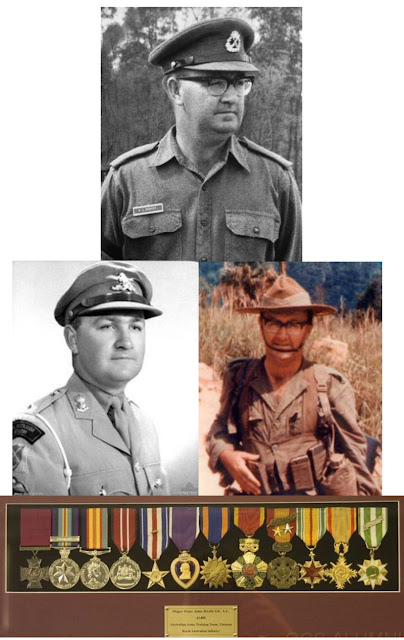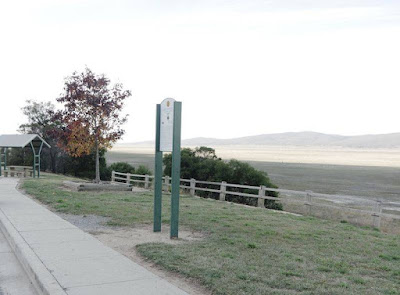-----------ooOoo-----------
The stories behind the names on the signs at the rest stops on the Remembrance Driveway, which goes from Sydney to Canberra.
The highway commemorates persons awarded the Victoria Cross by naming rest stops after them.
__________
The Victoria Cross (VC) is the highest and most prestigious award for gallantry in the face of the enemy that can be awarded to British and Commonwealth forces
The VC was introduced on 29 January 1856 by Queen Victoria to honour acts of valour during the Crimean War.
The metal used to make every Victoria Cross medal has been made from cannons captured by the British at the siege of Sevastopol.
__________
In 19991 the Victoria Cross for Australia was created, so that the VC no longer needed to be awarded by the British monarch. The Victoria Cross for Australia is the "decoration for according recognition to persons who in the presence of the enemy, perform acts of the most conspicuous gallantry, or daring or pre-eminent acts of valour or self-sacrifice or display extreme devotion to duty". Awards are granted by the Governor-General with the approval of the Sovereign.
__________
PETER BADCOE VC
Peter John Badcoe (1934 – 1967)
__________
Rest Stop:
Location:
Federal Highway, Lake George, Australian Capital Territory.
__________
Early life:
Badcoe was born Peter John Badcock on 11 January 1934 in the Adelaide suburb of Malvern, South Australia. His father, a public servant, was opposed him joining the Army. Despite his father's opposition, he enlisted in the Regular Army on 10 June 1950.
Badcoe graduated from the Officer Cadet School, Portsea, in 1952 as a second lieutenant in the Royal Australian Artillery.
r
In 1956, aged 22, he married 17-year-old Denise Maureen MacMahon in Sydney. Over the next five years, the couple had three daughters.
A series of regimental postings followed his graduation, including a tour in the Federation of Malaya in 1962, during which he spent a week in South Vietnam observing the fighting. During the previous year, Badcock had changed his surname to Badcoe. After another regimental posting, he transferred to the Royal Australian Infantry Corps, and was promoted to major.
Vietnam service:
He arrived in Saigon in August 1966 to fulfil his ambition of joining “The Team”, already regarded as an elite unit.
Badcoe was initially allotted as sub-sector adviser to Nam Hoa district of Thua Thien province, where the war was almost constant and intense. His role was to train and lead two companies of South Vietnamese territorial soldiers. In December he became operations officer, responsible for operations in the entire province.
The role of sector operations adviser at the provincial headquarters in Huế generally involved planning, liaison and staff work, but Badcoe interpreted his duty statement flexibly and led local forces into combat whenever he got the chance. According to a fellow AATTV officer, Captain Barry Rissel, he was a "veritable tiger" in combat, a characteristic that led his US allies to dub him "The Galloping Major". At his first meeting with Badcoe, Corporal Chris Black described the scene:
An old, bright red beret sat jauntily on his head. His drab jungle greens were almost hidden under the most amazing collection of weapons I have ever seen on one man. A Swedish sub-machine gun, his favourite, hung over one shoulder. It was balanced on the other side by a snub-nosed grenade launcher. On his belt an Australian pistol hung heavily and in one hand he heft an American machine-gun. He lowered the armament to the floor, crossed the room, shook hands, refused a drink and talked about his boys.
To his colleagues, Badcoe was a quiet but friendly officer with a dry sense of humour. He was an intensely private man whose wife remained his sole confidante. He neither drank alcohol nor smoked. Bored by boisterous mess activities, he preferred the company of a book on small arms or military history. In action, he seemed invincible, at the forefront of his troops, conspicuous in his red paratrooper beret.
Badcoe quickly acquired an understanding of the Vietnamese people, and an affectionate regard for the soldiers he trained and led. He traded spirits and souvenirs from the Australian canteen with American Marines in Danang in order to obtain equipment for his poorly provisioned troops. He also acquired food and supplies which he donated to a local orphanage.
He gradually grew disillusioned with the conduct of the conflict in Vietnam. He began to view it as “an unwinnable war”. After napalm airstrikes against a village occupied by the Viet Cong left 40 civilians dead or wounded, Badcoe spent two days trying to help survivors. The experience deeply disturbed him.
Nevertheless, in three separate actions in early 1967 he performed feats of individual heroism which earned him the Victoria Cross.
On the 23 February, during a small operation in Phu Thu district, he ran across some 600 metres of fire-swept open ground to assist a territorial platoon. Taking charge of the unit, Badcoe led it in a frontal attack. He single-handedly charged an enemy machine-gun post and shot the crew. He also retrieved the body of an American adviser killed in the action, and then braved further enemy fire to rescue another who was wounded.
On 7 March, the district headquarters of Quang Dien near Hue came under attack from a strong Viet Cong force. While commanding the province's reaction company, Badcoe organised and led a series of fierce assaults which drove out the Viet Cong and saved the headquarters.
One month later, on the 7 April 1967, he wrote to his wife: “It’s time I came home. I'm getting bitter and cynical … I can see more and more good about the Vietnamese and less and less about the US advisers.”
This was his last letter home.
That same day he learned that the Reaction Company of the South Vietnamese 1st Division was in difficulty near the hamlet of An Thuan. Knowing that the company would be denied air support unless advisers were present, he drove a jeep there with a US Army sergeant.
Finding that the force had fallen back, he took charge and rallied the men in the face of withering fire. Crawling ahead, he made several attempts to silence a machine-gun with grenades. At one stage the American sergeant pulled him out of the line of fire. Rising again to throw another grenade, Badcoe was shot and killed instantly.
Peter Badcoe had been an inspiration to his Australian, Vietnamese, and American comrades-in-arms. Attendance at his memorial service in Hue was the largest that could be recalled for any allied soldier.
He had confided to his wife that he believed military funerals were horrendous for families, so he preferred to be buried in Terendak military cemetery in Malaysia. His headstone bears the simple, poignant inscription provided by his widow: “He lived and died a soldier”.
Badcoe's grave in the Terendak Garrison Cemetery
In 2015, the Australian government repatriated the remains of 22 Australian soldiers buried at Terendak, but the Badcoe family asked that he remain buried there, in accordance with his express wishes.
Victoria Cross:
For his courage and leadership on 23 February, 7 March, and 7 April 1967, Badcoe was posthumously awarded the Victoria Cross, the highest award for gallantry in battle that could be awarded at that time to a member of the Australian armed forces.
Denise Badcoe received her husband's Victoria Cross from the Governor-General, Lord Casey, at Government House, Canberra, on 5 April 1968.
Badcoe was awarded the United States Silver Star with bronze oak leaf cluster, Air Medal and Purple Heart, and was made a Knight of the National Order of Vietnam. South Vietnam also awarded him the Cross of Gallantry with Palm, Gold Star, and Silver Star, the Armed Forces Honor Medal, First Class, Vietnam Campaign Medal and Wound Medal, and he posthumously received the Vietnam Medal and Australian Defence Medal from Australia.
The Official History of Australia's Involvement in Southeast Asian Conflicts 1948–1975 judged that Badcoe was "a dedicated career soldier" who "quickly acquired an understanding of the Vietnamese people and their customs along with an affectionate respect for the Vietnamese territorials he trained and led".
Afterwards:
The soldiers' club at the 1st Australian Support Compound in Vung Tau was named the Peter Badcoe Club in his honour in November 1967.
At Portsea, the assembly room and library was named after him, complete with a portrait and bronze plaque. After Portsea closed in 1985, the main lecture theatre in the Military Instruction Block at Royal Military College, Duntroon in Canberra was named after him.
In 1998–1999, a rest area in Badcoe's honour was established near Lake George on the Remembrance Driveway between Canberra and Sydney.
In 1999, the Ex-Military Rehabilitation Centre moved to the "Peter Badcoe VC Complex" at Edinburgh, South Australia.
In 2016, the South Australian electoral district of Ashford was renamed Badcoe in his honour.
In 2020, a 60-bed residential aged care facility named Peter Badcoe VC House was completed in Newcastle, New South Wales, by the Returned and Services League of Australia (New South Wales Branch) aged care arm, RSL LifeCare.
Since 2004, the award for the player displaying the most courage, skill, self-sacrifice and teamwork in the Australian Football League match in Adelaide on Anzac Day each year has been called the Peter Badcoe VC Medal. The medal has been won by three times by Travis Boak of the Port Adelaide Football Club, and twice by Joel Selwood of the Geelong Football Club.
Medals:
Badcoe's medal group and personal memoirs were offered for sale by auction in Sydney on 20 May 2008 and were sold for A$ 488,000 to the media magnate and philanthropist Kerry Stokes in collaboration with the Government of South Australia.
Badcoe's Victoria Cross and associated medals were displayed at the South Australian Museum in Adelaide, prior to being toured to 17 regional towns in South Australia between 21 March and 20 June 2009, before being displayed permanently at the Australian War Memorial in Canberra from 2016. His VC was the 71st of the 100 VCs awarded to Australians to be placed on public display there.
Gallery:
Second Lieutenant (later Major) Peter John Badcoe,
A group of Australian Army officers in Singapore with Badcoe in the centre wearing glasses.












No comments:
Post a Comment
Note: Only a member of this blog may post a comment.